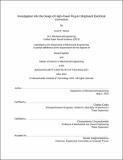Investigation into the Design of High-Power Plug-In Shipboard Electrical Connectors
Author(s)
Oberst, Scott D.
DownloadThesis PDF (4.613Mb)
Advisor
Cooke, Chathan
Chryssostomidis, Chryssostomos
Terms of use
Metadata
Show full item recordAbstract
High-power electrical connections are an essential component to all electric power systems. Such connections are important to the Navy as it increases the use of electric energy in ships. High power involves both high current and high voltage simultaneously and hence connections require careful design regarding both properties. While classical connections are typically bolted or welded, a plug-in type connection would greatly reduce installation time and enable more rapid reconfigurations or adjustments as loads are added or changed. This thesis presents the constraints surrounding electrical contacts and insulation requirements toward the development of a highpower plug-in type connector for Navy application. State-of-the-art plug-in contacts technology and mechanisms are identified. A comparison and selection process of dissimilar rated electrical contacts is proposed through the development of Figure of Merits. Insulation requirements, especially those surrounding creepage distance, are presented for high-power contacts across a range of voltages. Additional Navy specific insulation requirements are identified and related to the impact on a high-power connector. Constraints on both electrical contact and insulations requirements are considered and then applied to a 0.4 MW (1 kV, 400 amp) connector concept design. It illustrates the feasibility of developing a new Navy high-power connector. The concept design was fabricated using 3D printing to verify mechanical insertion force constraints were satisfied.
Date issued
2022-05Department
Massachusetts Institute of Technology. Department of Mechanical EngineeringPublisher
Massachusetts Institute of Technology